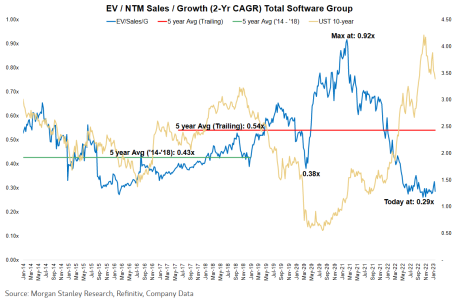A subscriber emailed me with a question last week that gets to the heart of a topic that’s often on my mind these days.
“What is the typical valuation for small and mid-cap software companies with about $100 million to $500 mill in revenue?”
Translated, the real question here is this; are small-cap and mid-cap stocks cheap or expensive? And therefore, are they a buy, hold or sell?
Software Stocks Are Inexpensive Relative to History
Morgan Stanley does a good job of aggregating data on software stocks. To answer the aforementioned question, I’ll be quoting numbers from the bank’s “Game of Margins” software research report from Monday, January 23.
The simple answer is that, in general, software stocks are trading at a discount to their historical valuations. It’s best to look at a couple of different time frames to understand the context, however.
Right now, a broad measure of software stocks is trading with an Enterprise Value to Forward Revenue (EV/Forward Revenue) multiple of 5.6.
[text_ad]
That’s a little lower than the average five-year multiple of 6.0 from 2014 to 2018. And it’s a lot lower than the average multiple of 9.9 from the last five years.
The caveat to looking at the last five years is that the EV/Forward Revenue multiple for software stocks surged in 2020 and 2021, peaking at 17.3. That skews the average for that period up. A more normalized average multiple over the last decade lands closer to 8.0.
The bottom line is that the data shows software stock valuations are below their historical averages. But they’ve been lower.
Software Stocks Are Cheap on a Growth-Adjusted Basis
If we adjust for growth, software stocks are decidedly cheap. Morgan Stanley layers in a two-year average growth rate to get the EV/Forward Revenue/Growth (2YR Average) multiple.
On that measure software stocks currently trade with a multiple of 0.29, well below both the average multiple of 0.43 from 2014 to 2018 and the average multiple of 0.54 from the last five years.
Morgan Stanley has a great chart showing this relationship. That chart is below.
What’s great about this chart is it adds in the 10-year yield (the yellow line). You can see that software stock valuations and the 10-year yield are inversely correlated during periods of extreme moves, such as in 2019 through 2020 (yields down, software valuations up) and 2021 through today (yields up, software valuations down).
What’s interesting is that this chart also shows it is possible for both yields and software valuations to rise and/or fall at the same time, provided neither moves too far too fast.
This was the case for much of the time from 2014 through 2018 when yields and software valuations trended down, then back up.
The Bottom Line
The bottom line is that software stocks are trading at a discount to their historical averages and are cheap on a growth-adjusted basis. But of course, stocks can always get cheaper.
When we consider the relationship between software stocks and yields it’s not overly surprising that these types of stocks have relatively low valuations today. After all, the Fed has made big rate hikes at a historically high pace.
It’s also not surprising that more investors are starting to think about the potential opportunity in software stocks.
The Fed’s rate hike program should be coming to an end, assuming inflation doesn’t pop back up. If so, the expected next trend in yields would be flat to down. Recall that expectations are the Fed target rate will peak at about 5%, much higher than it’s been for about 15 years.
Stable, then declining, yields could provide a nice tailwind for software stocks.
Of course, there is more to the story here. Software stocks with different growth rates, profit margins, cash flow, end markets, etc. will trade with different valuations and rise and fall for different reasons. Drilling down into all those factors is beyond the scope of what we can get into today.
Software Stocks to Buy Now
Big picture, I think investors would be well-served to look into software stocks now. I’m not saying jump in huge, but start to add some exposure to select ideas.
My preference is those in the small to mid-cap range (i.e., under around $10 billion market cap), growing revenue by at least 15%, growing profits (if not profitable now then having a line of sight to profits within a couple years) and with end-markets that are reasonably insulated from economic shocks.
I recently added a software stock that fits the bill to Cabot Small-Cap Confidential.
This company sells software to the financial services industry. Revenue has grown by an average of 24% over the last three years and should be up over 20% this year. It is delivering quarterly profits occasionally and should be profitable on a full-year basis next year.
The EV/Forward multiple on this stock is about 5.5. That’s higher than the recent low multiples of below 3.0 from last summer, but well below the peak multiple near 10.0 from 2021. I think the multiple can expand as the company becomes increasingly profitable.
The chart looks great too.
The trend is up, and the stock just moved above its May 2022 high, with barely a pause. That’s a rarity in this market, where a lot of stocks have paused, or fallen back when hitting overhead resistance.
You can learn more about this software stock, and all the other stocks I’m recommending right now, with a subscription to Cabot Small-Cap Confidential.
[author_ad]



